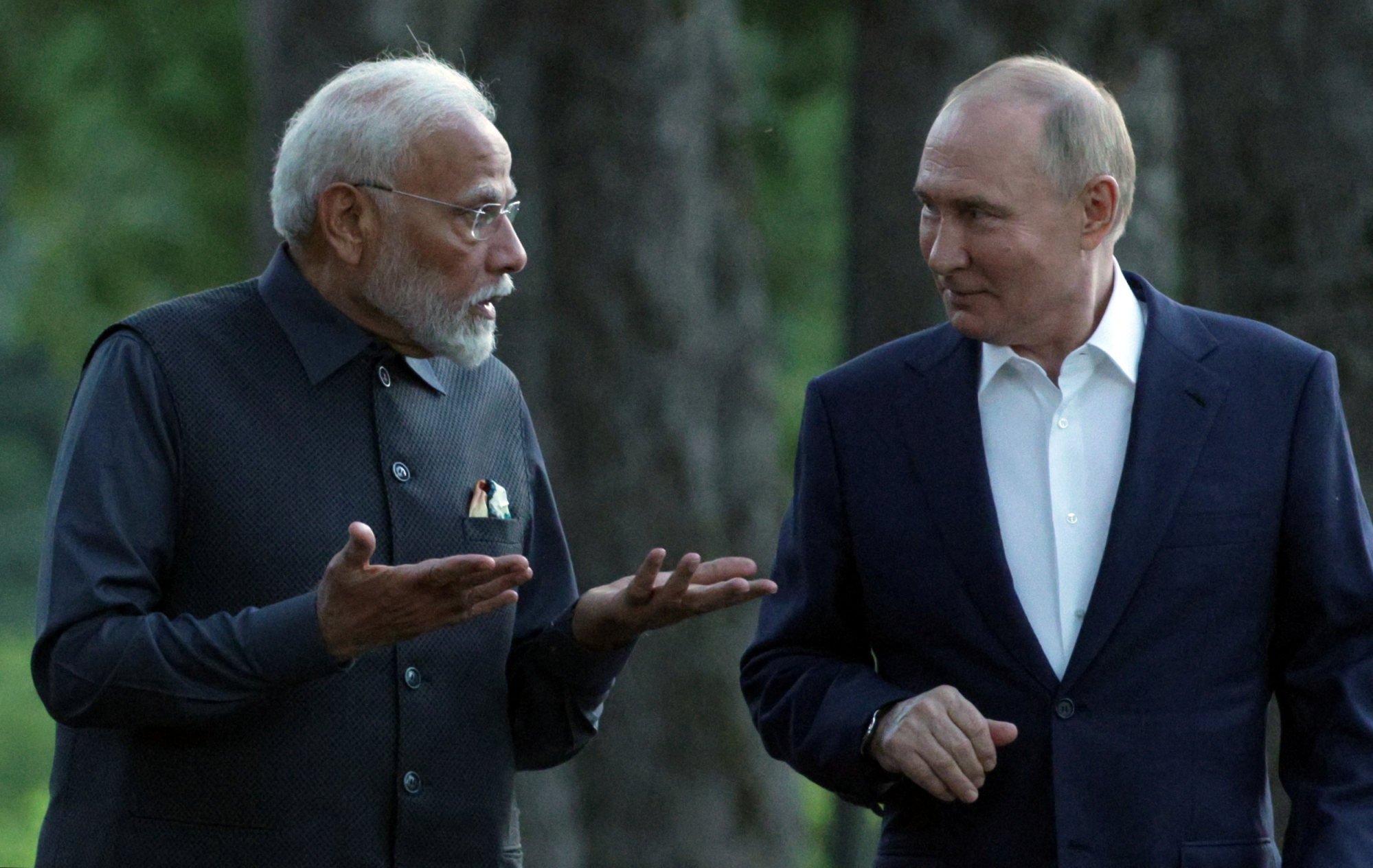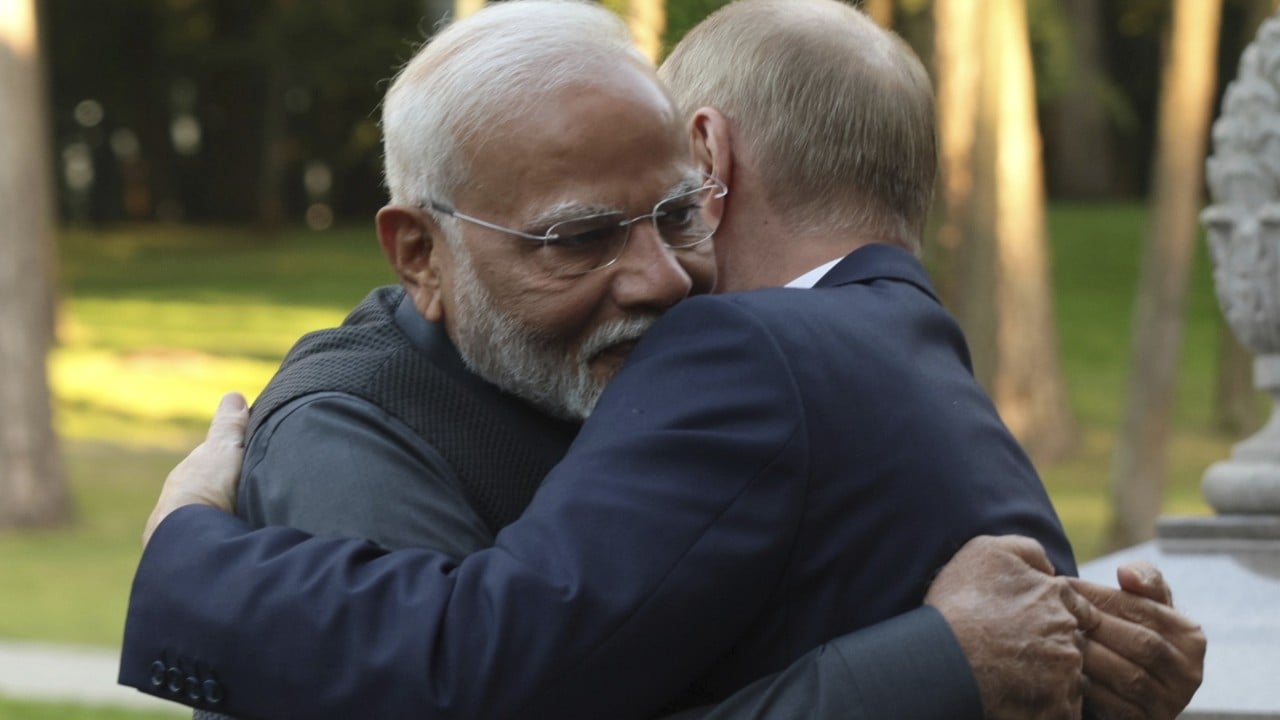In the game of power diplomacy, body language is often more revealing than words. Two photos showing interactions between leaders from Beijing, New Delhi and Moscow have effectively summed up the state of their trilateral relations.
One was Indian Prime Minister Narendra Modi’s bear hug with Russian President Vladimir Putin on Monday during his first visit to Moscow in nearly a decade. The other was taken in Beijing during Putin’s latest China visit in May, when he received a farewell hug from his Chinese counterpart Xi Jinping.
While Modi is famous for his public displays of warmth and “hug diplomacy”, neither Xi nor Putin are known as big fans of physical contact other than shaking hands, which partly explains why they both appeared a bit uncomfortable in the pictures.
That is probably why the photos have hit the international headlines, prompting Washington and its allies to scrutinise the roles Beijing and New Delhi may have played in enabling Putin’s grinding aggression against Ukraine.
When the White House was asked to comment on the Xi-Putin embrace, National Security Council spokesman John Kirby said wryly: “Well, that’s nice for them.”

Washington has good reasons to feel unease about the personal bonds between leaders of the two top US adversaries, with Beijing defying repeated threats of fresh Western sanctions over its perceived implicit support for Moscow over Ukraine.
In public, China has stopped talking about its “no limits” partnership with Russia in recent months, and Xi has refrained from referring to Putin as his “best, most intimate friend” following an international arrest warrant issued last year for the Russian leader.
But his photo with Putin was widely believed to have captured some rare, unscripted moments of China’s most powerful leader in decades. Unfazed by widespread criticism of Beijing’s warming ties with Moscow, Xi appeared to have initiated the embrace, raised his arms and hugged a seemingly hesitant Putin twice.
Beijing’s message is fairly clear – no matter how much it dislikes Putin’s expansionist war and the Western accusations about its entanglement as Russia’s top enabler, it cannot afford to give up on Moscow in the midst of its existential rivalry with Washington.

As war-beleaguered Moscow becomes increasingly reliant on Beijing, Xi sat down with Putin again last week on the sidelines of a security summit in Astana, Kazakhstan, reiterating support for Russia and their anti-US coalition.
But it is a different story for Putin.
Although he also hailed ties between Moscow and Beijing that were “experiencing the best period in their history” last week, the Russian strongman remains defiant and his hugs with Modi are probably a well-crafted message to the US-led West as well as Beijing.
Despite its isolation and deepening economic dependency on China, a weakened Russia still has other friends and partners to turn to, especially when Beijing is reluctant to throw all of its weight behind Putin’s costly war against Ukraine.
Following his trip to Beijing, Putin also visited Russia’s traditional allies North Korea and Vietnam last month, where he also enjoyed a red-carpet welcome and warm hugs.
Modi’s rare visit to Moscow is no doubt a major boost for Putin, on the eve of a Nato summit in Washington expected to be focused on how to help Ukraine win the war.
It shows that despite New Delhi’s strategic pivot to Washington in the US-China rivalry, Modi’s India is not choosing sides between the US and Russia, defying growing pressure from the White House.
Modi’s trip to Moscow, his first bilateral visit since he won a third term in office last month, marked a departure from past tradition for Indian leaders, who usually visit its South Asian neighbours first.

For Modi, the visit is clearly aimed at Beijing too, just days after he skipped the Astana summit of the Shanghai Cooperation Organisation (SCO), a political, economic and security platform founded by China and Russia in 2001 to challenge the US-led world order.
With Beijing and New Delhi showing little inclination to mend deeply troubled ties over a deadly border clash in eastern Ladakh in June 2020, India, which joined the SCO in 2017, has often been accused by critics in China of acting as a spoiler.
As the power balance between Russia and China becomes increasingly asymmetrical in the wake of the Ukraine war, Modi’s top priority during his visit is to ensure Moscow is not siding with Beijing in its increasingly acrimonious relations with New Delhi.
In other words, while New Delhi has to accept Moscow’s growing dependence on Beijing, China may also have had to live with the reality that Russia is still balancing between China and India, despite Beijing’s efforts to pull Moscow into its own orbit.
In both bilateral and triangular dynamics, Beijing is paying the price for its unwillingness to repair ties with New Delhi and end the prolonged border stand-off.
The fact that Xi is barely on speaking terms with Modi has not only offered openings for Moscow and others, but also undermines its own efforts to position itself as a leader for the Global South.


